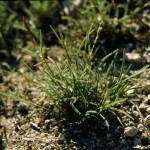Common Curly-mesquite , Curly Mesquite, Curly Mesquite Grass
Hilaria belangeri (Steud.) Nash
Poaceae
Description
Curly Mesquite forms sod with slender, creeping stolons that take root at the leafy nodes. The stems are pale green. The blades are densely tufted, curly, and grayish-green in color. Internodes are alternatively curved. The foliage turns yellow after frost. The stolons are long, wiry, rough, and have hair at the nodes. It resembles Buffalograss, except that Buffalograss is smooth, and Curly Mesquite is more drought tolerant. The single spike-like seed head shows a zig-zag stem when the florets fall. Curly Mesquite blooms from March to November but typically does not begin until the summer. It can reproduce by seed but more commonly uses long stolons that establish new tufts, which allow the plant to spread up to 13 ft or 4 m away. Curly Mesquite is a perennial, warm-season, native shortgrass ranging from 4 to 12 inches or 10 to 30 cm tall. It provides fair to good grazing for livestock. It is one of the most palatable grasses in the Southwest region of the United States. Fair forage for wildlife including pronghorn and deer species. Seeds are consumed by granivorous bird species, and it also provides nesting material.Habitat
Common Curly-mesquite grows on plains, prairies, rocky slopes, mesas, and dry, open foothills. It withstands heavy grazing and responds well to disturbance but is not drought resistant. Curly Mesquite becomes dormant during a drought. It prefers dry, rocky soils. Its native distribution ranges from Central Texas to Arizona and south to Nuevo Leon. Habitat types include deserts, semi-desert grasslands, short and mid-range grasslands, and shrub-steppes.Images
Plant Characteristics
Seed Type: Non-Encapsulated
Duration: Perennial
Stem Texture: Hairy
Growth Habit: Grasses, Sod grass
Leaf Shape
 : Simple with Pinnate or Parallel Venation
: Simple with Pinnate or Parallel Venation
Season: Warm
Distribution
 : 02 - Gulf Prairies and Marshes, 04 - Blackland Prairies, 05 - Cross Timbers and Prairies, 06 - South Texas Plains, 07 - Edwards Plateau, 08 - Rolling Plains, 09 - High Plains, 10 - Trans-Pecos
: 02 - Gulf Prairies and Marshes, 04 - Blackland Prairies, 05 - Cross Timbers and Prairies, 06 - South Texas Plains, 07 - Edwards Plateau, 08 - Rolling Plains, 09 - High Plains, 10 - Trans-Pecos
Distributions
Distribution refers to the ecological region in Texas that a plant has been found. You can also view a clickable map.
Book: Know Your Grasses (B-182)
Collection: Grasses


